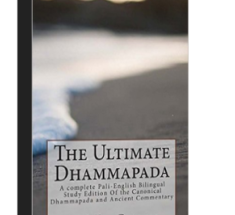Here is a very beautiful description by the Buddha on the progressive stages a meditator goes through until he realizes Nirvana. It sheds some additional light on the progress of insight meditation which the later commentary literature called “insight-knowledges” or “vipassana nyana”. It is not easy to spot these gems in the suttas (discourses of the Buddha) because you do have to know what you are looking at. Without further ado, vipassana nyana’s in the words of the Buddha:
Udayi, there are four persons evident in the world. What are the four?
Udayi, a certain person falls to the method of dispelling and giving up endearments. Thoughts about endearments assail him, he endures them, does not dispel them and make them not to rise again. Udayi, I say this person is yoked. What is the reason? I know this person through my developped mental faculties.
A certain person, comes to the method of dispelling and giving up endearments. Thoughts about endearments assail him. He does not endure them, dispels them and makes them not to rise again. Udayi, I say this person too is yoked. What is the reason? I know this person through my developped mental faculties.
Udaayi, a certain person falls to the method of dispelling and giving up endearments. On account of lapses in mindfulness, thoughts about endearments arise, mindfulness arises to him slowly, and he instantly dispels them, and makes them not to rise again. Like a man dropping a few drops of water to an iron pot heated through out the day. The falling of the water may be slow, but the water vanishes instantly. Udayi, in the same manner a certain person falls to the method of dispelling and giving up endearments. On account of lapses in mindfulness, thoughts about endearments arise, mindfulness arises to him slowly, and he instantly dispels them, and makes them not to rise again.I say this person too is yoked. What is the reason? I know this person through my developped mental faculties.
Udayi a certain person, knowing that endearments are the origin of unpeasantness, frees himself from endearments and the reckonings of endearments and is released Udayi, I say this person is unyoked. What is the reason? I know this person through my developped mental faculties. .{MN 66}
As Buddhist philosophy grew out of Siddhartha’s early experience under the Bodhi tree even during his live into a full fledged philosophy it never stopped evolving for thousands of years. Currently we use terminology from all periods of Buddhist thought interchangeably but that might lead to confusion if we take our current understanding of what we think Buddhism “is” and are shocked then, when we hear the Buddha for the first time in his own words.
[Update]
Some great points in the comment section made me look at Bhikkhu Thanissaro’s translation (accesstoinsight.com MN66). He uses the term “acquisition” instead of “endearment”. In Pali we find the term “upadhi”, which is quite a fascinating term. Some of you might remember Ven. Katukurunde Nyanananda’s excellent discussion on this topic in his writings. Here is the Pali version:
Cattāro me udāyi puggalā santo saṃvijjamānā lokasmiṃ, katame cattāro: idhūdāyi ekacco puggalo upadhipahānāya paṭipanno hoti upadhipaṭinissaggāya. Tamenaṃ upadhipahānāya paṭipannaṃ upadhipaṭinissaggāya upadhipaṭisaññuttā sarasaṅkappā samudācaranti. So te adhivāseti, nappajahati, na vinodeti. Na byantīkaroti. Na anabhāvaṃ gameti. Imaṃ kho ahaṃ udāyi puggalaṃ saññutto’ti vadāmi no visaññutto. Taṃ kissa hetu: indriyavemattatā hi me udāyi imasmiṃ puggale viditā.
Idha panudāyi ekacco puggalo upadhipahānāya paṭipanno hoti upadhipaṭinissaggāya. Tamenaṃ upadhipahānāya paṭipannaṃ upadhipaṭinissaggāya, upadhipaṭisaññuttā sarasaṅkappā samudācaranti. So te nādhivāseti, pajahati, vinodeti, byantīkaroti, anabhāvaṃ gameti. Imampi kho ahaṃ udāyi puggalaṃ saññuttoti vadāmi no visaññutto. Taṃ kissa hetu: indriyavemattatā hi me udāyi imasmiṃ puggale viditā.
Idha panudāyi ekacco puggalo upadhipahānāya paṭipanno hoti upadhipaṭinissaggāya. Tamenaṃ upadhipahānāya paṭipannaṃ upadhipaṭinissaggāya kadāci karahaci satisammosā upadhipaṭisaññuttā sarasaṅkappā samudācaranti. Dandho udāyi satuppādo. Atha kho naṃ khippameva pajahati, vinodeti, byantīkaroti, anabhāvaṃ gameti. Seyyathāpi udāyi puriso divasasantatte ayokaṭāhe dve vā tīṇi vā udakaphusitāni nipāteyya. Dandho udāyi udakaphusitānaṃ nipāto. Atha kho naṃ khippameva parikkhayaṃ pariyādānaṃ gaccheyya. Evameva kho udāyi idhekacco puggalo upadhipahānāya paṭipanno hoti upadhipaṭinissaggāya. Tamenaṃ upadhipahānāya paṭipannaṃ upadhipaṭinissaggāya, kadāci karahaci satisammosā upadhipaṭisaññuttā sarasaṅkappā samudācaranti. Dandho udāyi satuppādo. Atha kho naṃ khippameva pajahati, vinodeti, byantīkaroti, anabhāvaṃ gameti. Imampi kho ahaṃ udāyi puggalaṃ saññutto’ti vadāmi no visaññutto, [PTS Page 454] taṃ kissa hetu: indriyavemattatā hi me udāyi imasmiṃ puggale viditā.
Idha panudāyi ekacco puggalo ‘upadhi dukkhassa mūla‘nti iti viditvā nirupadhi hoti upadhisaṅkhaye vimutto, imaṃ kho ahaṃ udāyi puggalaṃ visaññutto’ti vadāmi no saññutto. Taṃ kissa hetu: indriyavemattatā hi me udāyi imasmiṃ puggale viditā.
Upadhi, the central term of this discourse of course is not just morphologically related to the famous “upadana” of the five “groups of grasping”. It’s the activity of “picking up a log (khandha in a sense) of firewood in the forest (of sense experience), clutching it tight, holding it close to your body (upa in a sense) and carrying it with you that is seen, here, by the Buddha, as the cause for all evil (dukkhassa mulam).
Mental freedom, then, according to the Buddha’s insight, needs to lead to a “throwing away” (pati-nissagga) of the firewood that’s on fire (by the six senses, the world of sensual experience), burning our hand and body. The process of this “letting go” is described above.
Filled with gems too, is Ven. Nyananda’s short book “Towards Calm and Insight” which has this to say about upadhi and upadana’s relationship:
If “upàdànas” are “clutches”, “upadhis” are “crutches” (“upàdàna” = “grasping”; “upadhi” = “asset”)
and in Nibbana Sermon 16:
Gāme araññe sukhadukkhaphuṭṭho,
nev’attato no parato dahetha,
phusanti phassā upadhiṃ paṭicca,
Nirūpadhiṃ kena phuseyyum phassā
In the first two lines we get an instruction:
“Touched by pain in village or in forest,
Think not in terms of oneself or others”
The reason for it is given in the norm of Dhamma which follows:
“Touches can touch one, because of assets,
How can touches touch him, who is asset-less?”




Branko
I’m glad you started posting here again!
theravadin
Authorwas about time 🙂
In fact I am looking for co-authors. Theravada practicioners who would like to share their meditation/Dhamma/Pali insights…
jayarava
I’m also pleased your posting again. I’m not sure about “endearments”. An “endearment” is usually a nice thing you say about someone to indicate you like them. Although, of course other forms do work a bit like this, e.g. we can try to “endear” ourselves (make us dear) to another.
theravadin
AuthorHi Jayarava, thanks so much! I have to check where I picked up this translation, it’s definitely not modern choice of words, but I guess that’s what makes it so endearing to me 😉 PS: I guess now I’ll have to create a Pali version based on your version as well 🙂
davekiwidavid stringer
I believe the Buddha was referring to those things we find “dear” to us. Thus we cling to them. Ultimately this would include everything we encounter in this life, as they are all included within the five skandas: form, sensation, perception, mental constructions and consciousness.
Jonathan Dupré
So happy you’re posting again!
Dasun
Good to see you post again!
Dhamma Bum
Theravadin, thank you for your lesson in patience; I’ve been waiting for almost three years for your next post and here it is. You are indeed a great teacher even when you post nothing 🙂